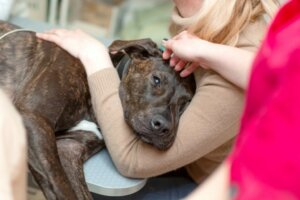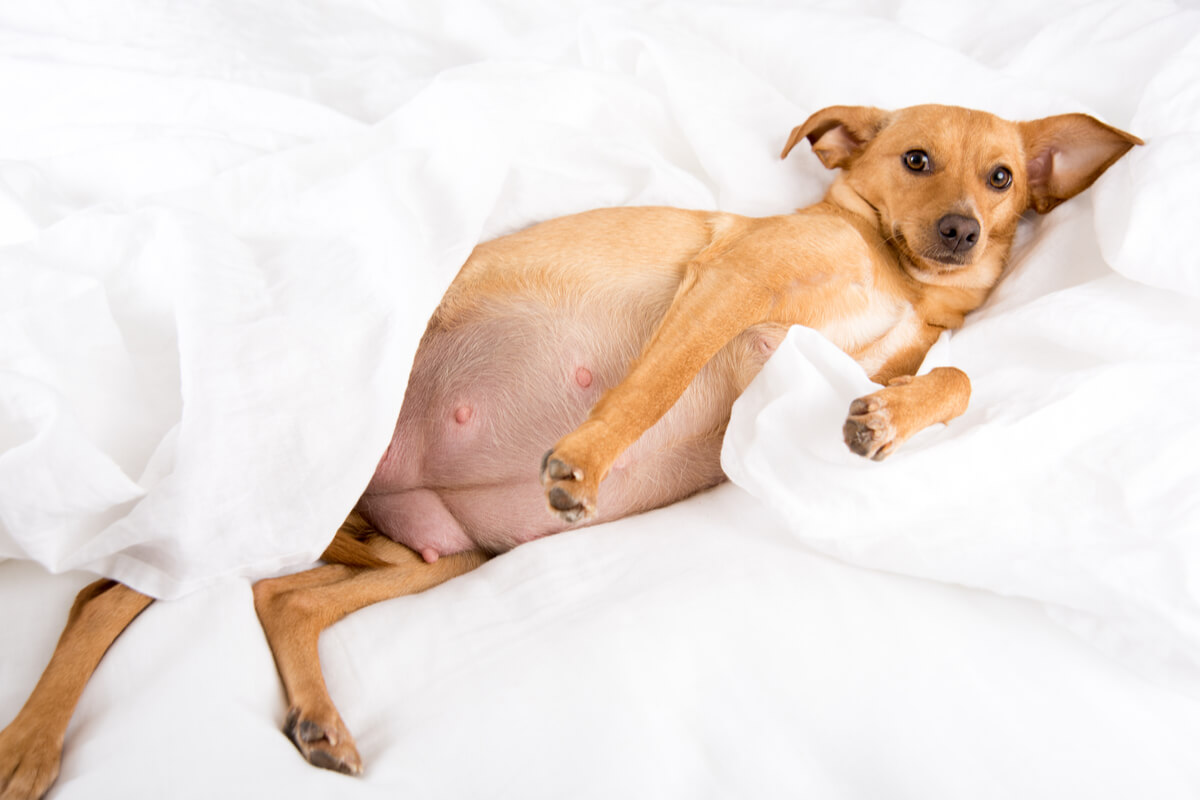Dystocia in Bitches: Causes, Symptoms and Treatment


Written and verified by the vet Daniel Aguilar
Pregnant dogs require attention before, during, and after pregnancy. Each of these stages requires specific medical care to help preserve the animal’s health. If your pet is soon to become a mother, then read this article carefully, because it could be at risk from a distressing process known as dystocia in bitches.
As in many diseases, the implementation of preventive measures is key to avoid potential complications. In this article, we’ll explain the reasons why dogs can develop this condition, along with a few hints that will be very useful to help you identify the problem from the beginning. Keep reading!
What is dystocia in bitches?
Dystocia in bitches is defined as an abnormal process of childbirth in which the female dog is unable to expel the fetus. The complications that your pet can develop need to be attended to urgently by professionals, otherwise the life of the mother and the newborn will be exposed to great danger.
Among the many risks involved in labor, it’s considered that 5% of pregnant female dogs may develop dystocia. The duration of labor is closely related to pup mortality, with hypoxia (a lack of oxygen) being one of the most common causes of death in puppies.
Although all dogs may develop dystocia during labor, some breeds have morphological characteristics that increase their predisposition. Dystocia is common in brachycephalic bitches belonging to breeds such as the English bulldog, the French bulldog and the pug, as well as miniature dogs such as the Chihuahua, the Pekingese, and the Yorkshire terrier.

Main causes of dystocia in bitches
For dystocia in bitches to manifest itself, certain factors need to intervene. For example, poor fetal posture, abnormal position in the uterus, large puppies, and poor presentation of the vaginal lumen. However, the main reason lies in some maternal and fetal processes that we’ll share with you below.
Maternal origin
Most of the maternal processes that trigger dystocia in bitches are related to reproductive and nutritional pathologies. Some of them are the following:
- Uterine rupture
- Uterine torsion
- Bone problems and pelvic fractures
- Alterations of the vaginal canal
During parturition, the canine uterus performs some movements whose purpose is to expel the fetus from its interior. However, in some dogs, a problem known as primary uterine inertia occurs, in which the uterine contractions don’t start, leaving the bitch in the dilation phase and complicating the expulsion.
Another triggering factor of dystocia in bitches is the exhaustion of the uterine muscle during contractions. In bitches with large litters and suffering from uterine obstruction, expulsion movements may stop. This type of condition is called secondary uterine inertia.
Fetal origin
Prior to birth, the puppy needs to be positioned with its head and both limbs extended correctly. If, for some reason, this doesn’t happen and the pup is badly positioned, then it’s very likely to create a dystocic birth.
If your pet is pregnant, we recommend a close medical monitoring, with which you can detect certain abnormal processes in time and thus protect your furry friend. Some of them are the following:
- Fetuses that are too large
- Anasarca (generalized fetal edema)
- Deformed fetuses
- Dead products
Symptoms of dystocia in bitches
When it comes to dystocia problems in bitches, observation will be your best tool. Once labor begins, keep an eye on your pet. If you identify any of these abnormalities, don’t hesitate to make an emergency visit to your veterinarian:
- Prolonged and unproductive contractions for more than half an hour without expulsion of anything.
- Signs of pain on the part of the mother.
- A dark green pestilent fluid coming from the vulva.
- Fetuses halfway out for more than 15 minutes.
Diagnostic methods
The first step in arriving at a diagnosis of dystocia in bitches is to perform a complete physical and clinical examination of the patient. In addition to checking her pregnancy, the veterinarian will check her vital signs and perform an abdominal palpation. It will also be possible to assess the condition of the vaginal canal, thus ruling out signs of uterine obstruction.
Other excellent diagnostic tools that allow observation of the number of pups and their current position are radiological tests and ultrasonography. The veterinarian may use these to confirm dystocia in bitches.
It’s important to constantly monitor the fetuses. Their heart rate is usually at 200 bpm (beats per minute) or double that of the mother at the time of the tests. A drop in heart rate to 160 bpm is an indicator of fetal stress and the likelihood of dystocia increases.
Treatment of dystocia in bitches
The therapeutic actions to choose will depend on the breed and the severity of the problem. Ideally, comprehensive support based on manual and pharmacologic techniques should be used.
To begin management, the perianal region should be sanitized and the birth canal lubricated. Once it has been ascertained that the fetuses are malpositioned, by inserting the middle and index fingers, an attempt will be made to reposition them. If possible, the doctor will be able to extract them gently. Otherwise, an emergency caesarean section will be necessary.
The administration of drugs (such as oxytocin or calcium gluconate 10%) is indicated in bitches with dystocia due to uterine inertia. The purpose is to accelerate the delivery of the fetuses, evacuate the fetal membranes, and promote uterine involution. Both drugs are contraindicated in patients with obstructive dystocia.
If, after trying these treatments, your pet doesn’t show any improvement, surgical intervention will be necessary. Cesarean section is indicated in patients with vaginal and pelvic obstructions, fetal malformations, and in certain predisposed breeds. An ovariohysterectomy (removal of the uterus and ovaries) isn’t ruled out in bitches with severe dystocia.

The prognosis of dystocia in bitches is usually uncertain, but knowing how to correctly manage gestation from the first days until after delivery will greatly reduce the risk of maternal and fetal death. If your pet is in the risk group and you’re planning for your doggy family to grow, have a word with an expert and follow their recommendations.
Pregnant dogs require attention before, during, and after pregnancy. Each of these stages requires specific medical care to help preserve the animal’s health. If your pet is soon to become a mother, then read this article carefully, because it could be at risk from a distressing process known as dystocia in bitches.
As in many diseases, the implementation of preventive measures is key to avoid potential complications. In this article, we’ll explain the reasons why dogs can develop this condition, along with a few hints that will be very useful to help you identify the problem from the beginning. Keep reading!
What is dystocia in bitches?
Dystocia in bitches is defined as an abnormal process of childbirth in which the female dog is unable to expel the fetus. The complications that your pet can develop need to be attended to urgently by professionals, otherwise the life of the mother and the newborn will be exposed to great danger.
Among the many risks involved in labor, it’s considered that 5% of pregnant female dogs may develop dystocia. The duration of labor is closely related to pup mortality, with hypoxia (a lack of oxygen) being one of the most common causes of death in puppies.
Although all dogs may develop dystocia during labor, some breeds have morphological characteristics that increase their predisposition. Dystocia is common in brachycephalic bitches belonging to breeds such as the English bulldog, the French bulldog and the pug, as well as miniature dogs such as the Chihuahua, the Pekingese, and the Yorkshire terrier.

Main causes of dystocia in bitches
For dystocia in bitches to manifest itself, certain factors need to intervene. For example, poor fetal posture, abnormal position in the uterus, large puppies, and poor presentation of the vaginal lumen. However, the main reason lies in some maternal and fetal processes that we’ll share with you below.
Maternal origin
Most of the maternal processes that trigger dystocia in bitches are related to reproductive and nutritional pathologies. Some of them are the following:
- Uterine rupture
- Uterine torsion
- Bone problems and pelvic fractures
- Alterations of the vaginal canal
During parturition, the canine uterus performs some movements whose purpose is to expel the fetus from its interior. However, in some dogs, a problem known as primary uterine inertia occurs, in which the uterine contractions don’t start, leaving the bitch in the dilation phase and complicating the expulsion.
Another triggering factor of dystocia in bitches is the exhaustion of the uterine muscle during contractions. In bitches with large litters and suffering from uterine obstruction, expulsion movements may stop. This type of condition is called secondary uterine inertia.
Fetal origin
Prior to birth, the puppy needs to be positioned with its head and both limbs extended correctly. If, for some reason, this doesn’t happen and the pup is badly positioned, then it’s very likely to create a dystocic birth.
If your pet is pregnant, we recommend a close medical monitoring, with which you can detect certain abnormal processes in time and thus protect your furry friend. Some of them are the following:
- Fetuses that are too large
- Anasarca (generalized fetal edema)
- Deformed fetuses
- Dead products
Symptoms of dystocia in bitches
When it comes to dystocia problems in bitches, observation will be your best tool. Once labor begins, keep an eye on your pet. If you identify any of these abnormalities, don’t hesitate to make an emergency visit to your veterinarian:
- Prolonged and unproductive contractions for more than half an hour without expulsion of anything.
- Signs of pain on the part of the mother.
- A dark green pestilent fluid coming from the vulva.
- Fetuses halfway out for more than 15 minutes.
Diagnostic methods
The first step in arriving at a diagnosis of dystocia in bitches is to perform a complete physical and clinical examination of the patient. In addition to checking her pregnancy, the veterinarian will check her vital signs and perform an abdominal palpation. It will also be possible to assess the condition of the vaginal canal, thus ruling out signs of uterine obstruction.
Other excellent diagnostic tools that allow observation of the number of pups and their current position are radiological tests and ultrasonography. The veterinarian may use these to confirm dystocia in bitches.
It’s important to constantly monitor the fetuses. Their heart rate is usually at 200 bpm (beats per minute) or double that of the mother at the time of the tests. A drop in heart rate to 160 bpm is an indicator of fetal stress and the likelihood of dystocia increases.
Treatment of dystocia in bitches
The therapeutic actions to choose will depend on the breed and the severity of the problem. Ideally, comprehensive support based on manual and pharmacologic techniques should be used.
To begin management, the perianal region should be sanitized and the birth canal lubricated. Once it has been ascertained that the fetuses are malpositioned, by inserting the middle and index fingers, an attempt will be made to reposition them. If possible, the doctor will be able to extract them gently. Otherwise, an emergency caesarean section will be necessary.
The administration of drugs (such as oxytocin or calcium gluconate 10%) is indicated in bitches with dystocia due to uterine inertia. The purpose is to accelerate the delivery of the fetuses, evacuate the fetal membranes, and promote uterine involution. Both drugs are contraindicated in patients with obstructive dystocia.
If, after trying these treatments, your pet doesn’t show any improvement, surgical intervention will be necessary. Cesarean section is indicated in patients with vaginal and pelvic obstructions, fetal malformations, and in certain predisposed breeds. An ovariohysterectomy (removal of the uterus and ovaries) isn’t ruled out in bitches with severe dystocia.

The prognosis of dystocia in bitches is usually uncertain, but knowing how to correctly manage gestation from the first days until after delivery will greatly reduce the risk of maternal and fetal death. If your pet is in the risk group and you’re planning for your doggy family to grow, have a word with an expert and follow their recommendations.
All cited sources were thoroughly reviewed by our team to ensure their quality, reliability, currency, and validity. The bibliography of this article was considered reliable and of academic or scientific accuracy.
Beratz A. Distocia canina: Importancia del manejo y seguimiento de la hembra gestante. Buenos aires, Argentina. Publicado en marzo de 2020. Consultado el 04 de noviembre de 2021. Disponible en: https://www.ridaa.unicen.edu.ar/xmlui/bitstream/handle/123456789/2844/BERATZ%2c%20FLORENCIA.pdf?sequence=1&isAllowed=y
Martínez S. Eutocia y distocia canina: Estudio recapitulativo. México. Publicado en junio de 1993. Consultado el 04 de noviembre de 2021. Disponible en: http://132.248.9.195/pmig2016/0193912/0193912.pdf
Martí S. La distocia en la perra. Madrid, España. Publicado el 17 de noviembre de 2019. Consultado el 04 de noviembre de 2021. Disponible en: https://www.portalveterinaria.com/articoli/articulos/28006/la-distocia-en-la-perra.html
Reyes M. Características y cuidados de la preñez y parto de la perra. Chile. Publicado en marzo de 1999. Consultado el 04 de noviembre d 2021. Disponible en: https://web.uchile.cl/vignette/tecnovet/CDA/tecnovet_articulo/0,1409,SCID%253D9667%2526ISID%253D459,00.html
Las complicaciones en el parto de las perras. España. Publicado el 18 de junio de 2015. Consultado el 04 de noviembre de 2021. Disponible en: https://blog.arion-petfood.es/las-complicaciones-en-el-parto-de-las-perras/
This text is provided for informational purposes only and does not replace consultation with a professional. If in doubt, consult your specialist.








